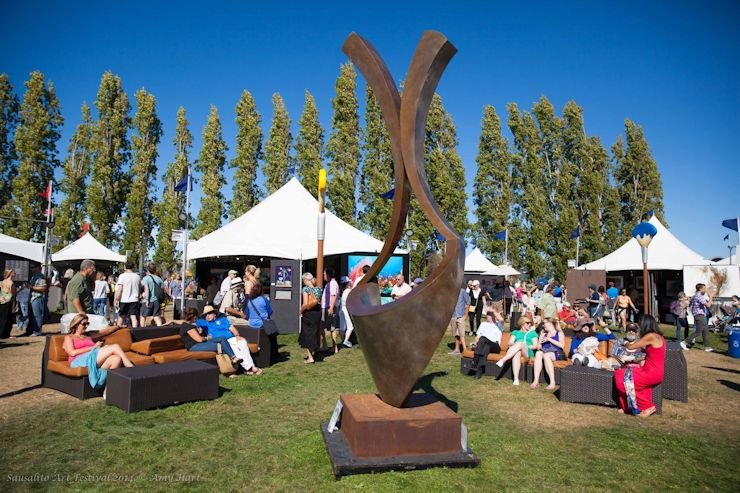By Larry Clinton, Sausalito Historical Society
A recent announcement that the Sausalito Art Festival would be postponed for another year got me reminiscing about the festival’s on-and-off history.
In his book Moments in Time, Jack Tracy points out:
“Sausalito in 1950 was on the threshold of its ‘art colony’ years. Always a haven for writers, artists., poets and creative souls of many bents, Sausalito experienced an influx of artists in the decade after World War II.
“Art shows held in various places evolved into an annual art festival, with established artists mingling with newcomers. Many well-known Bay Area artists emerged from the Sausalito art colony of the 1950s.”
The Art Festival Foundation, which manages the festival, reported in 2011:
“The Sausalito Art Festival, one of the leading outdoor fine art festivals in the United States, has attracted more than one million art enthusiasts, museum curators, and private collectors since it began in 1952.
“The first festival was held on September 6, 1952, at Shell Beach, where the Spinnaker Restaurant is now located. Over the next 25 years, several groups produced the festival.”
Historical Society Board member Bill Kirsch, was one of those early organizers. Bill, who passed away in 2018, co-wrote a column for this paper commemorating the festival’s 60th anniversary in 2012. Here are some lightly-edited excerpts from that column:
“In the 1950s, Jean Varda, Ed Spolin and other local artists produced the Sausalito Art Festival on the sand spit before the Spinnaker Restaurant was built. Eventually they pursued other interests and didn’t want to produce festivals any longer, and so there were no festivals for several years.”
Current SHS Board member Nora Sawyer reported a fascinating account from those dark years in the August 29, 2018, Marinscope. In 1955, the Sausalito Art Center, which had sponsored the festival since 1952, was unable to muster enough interest or volunteer power to pull it off. In July, the Center took a “vote of apathy,” cancelling the event. Avant garde painter Enid Foster responded by proposing a procession down Bridgeway led by a band or two. Nora wrote: “After some consideration, the city council refused to grant a permit, citing the inconvenience of shutting down streets on a busy afternoon and the immutability of bus schedules.
“Muralist Val Bleeker came up with a solution. If busy streets made an afternoon parade impossible, why not hold the parade at the “’ess conspicuous hour’ of 5 AM?
“After much discussion, the city council agreed, on the condition that the parade not disturb the early morning peace, and parade participants stay on sidewalks as much as possible.
“And so, on the fog-bound morning of October 15th, a small group of artists, Sausalitans, and reporters assembled.
“Foster took the lead as the parade’s grand marshal. Val Bleeker carried a sign reading “Silence! Genius at Work.”
Bill Kirsch described what happened next: “In the early ‘60s, the Sausalito Chamber of Commerce put on the festivals in the yard at Central School, School, which is now City Hall. The artists became increasingly critical of the way the Chamber was running the festival, so in 1966 the artists took over the festival. They formed their own Sausalito Arts Association, with the intention of producing the art show themselves. The artists wanted to bring the festival back downtown, so a committee of artists lobbied the City Council to use the parking lot next to the Bank of America for the festival.” Bill and his colleague Michael Bry were elected cochairmen of the 1966 art festival.
“The festivals held next to the Bank of America in 1966 and 1967 were hugely successful; received critical acclaim and drew vast crowds of people that caused the biggest traffic jams in the history of Sausalito. The merchants complained that the festivals were ruining their business.
“Enough money was earned to rent the abandoned school on King Street and remodel it into ateliers for painters and sculptors, facilities for ceramicists and glass blowers and a room for the performing arts. Al Garvey was the art center’s first director, and for the next several years the art shows were held at the remodeled Sausalito Art Center. In 1971 the building was rented to another tenant, the Art Center disbanded, and the Chamber of Commerce took over the festival once again. The festival evolved into the internationally known Sausalito Art Festival.”
Stay tuned for the next installment of this ever-changing institution
Bill’s and Nora’s columns can be read in their entirety on the MarinScope Columns page at www.sausalitohistoricalsociety.com.
PHOTO FROM ART FESTIVAL FOUNDATION
The Art Festival was once one of the largest in the U.S.

